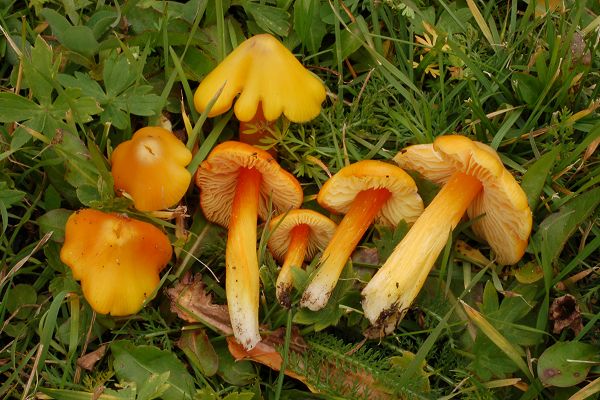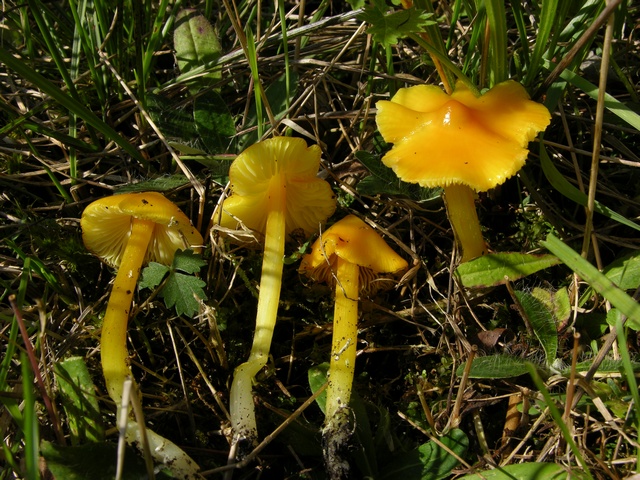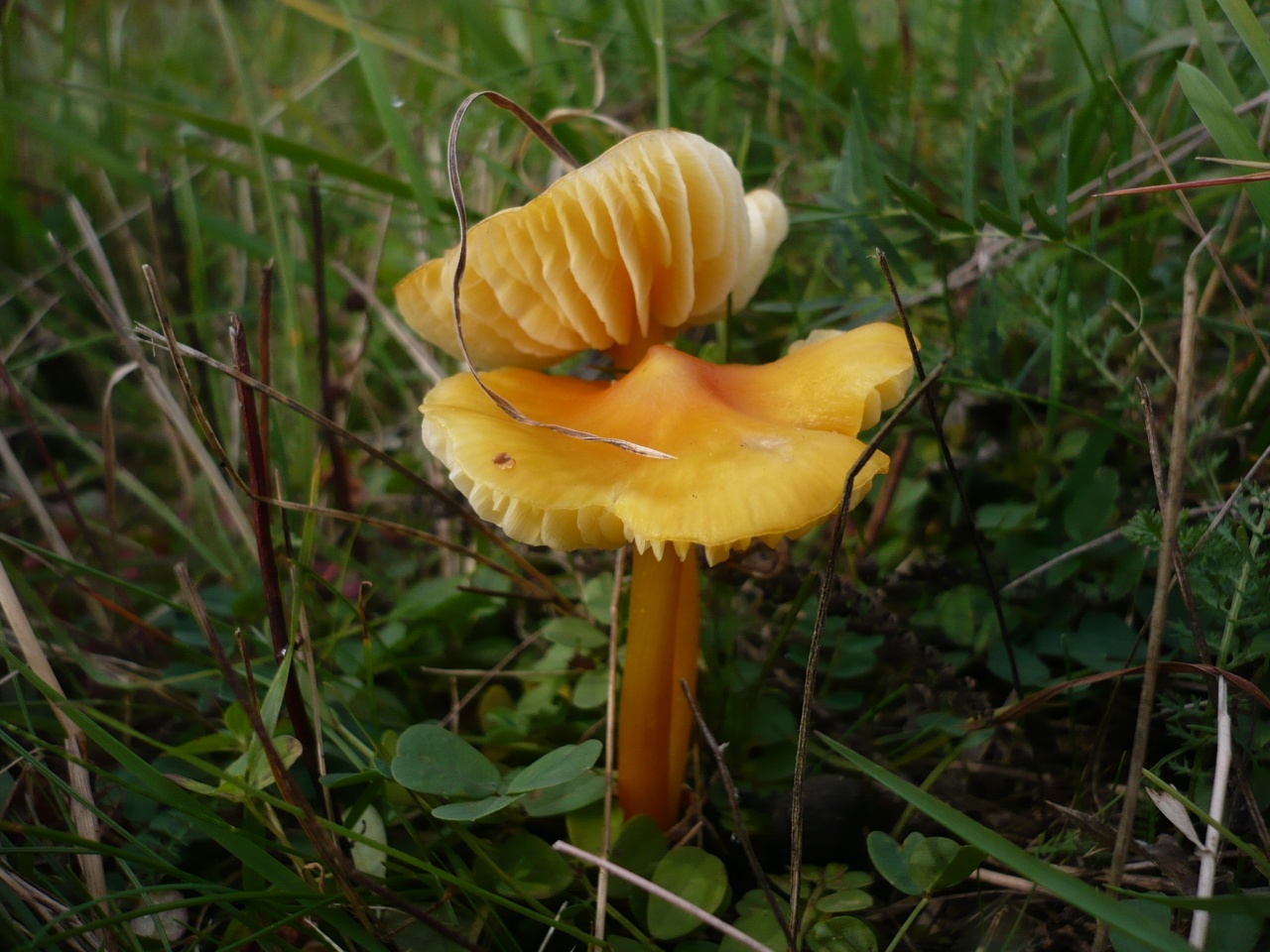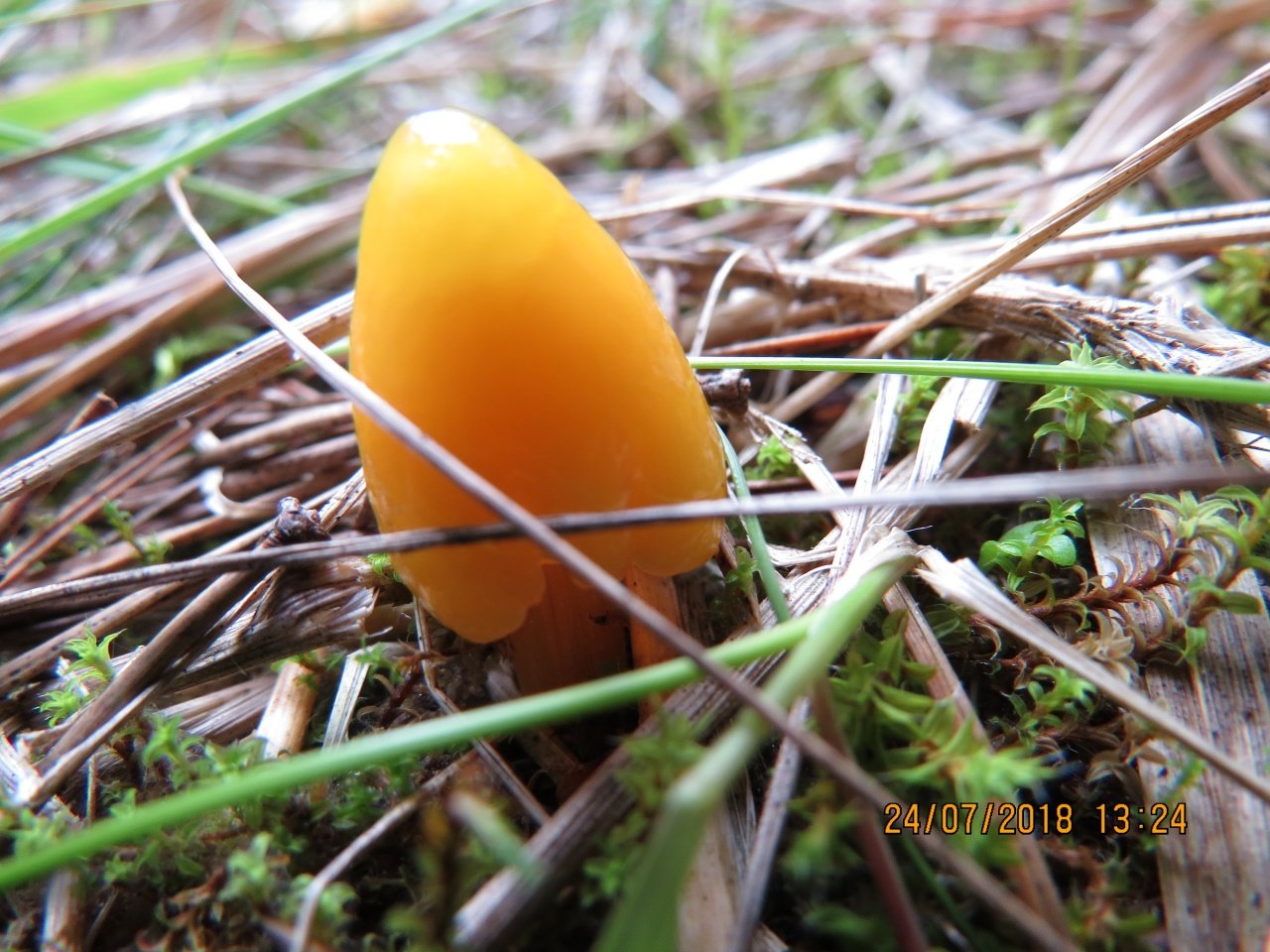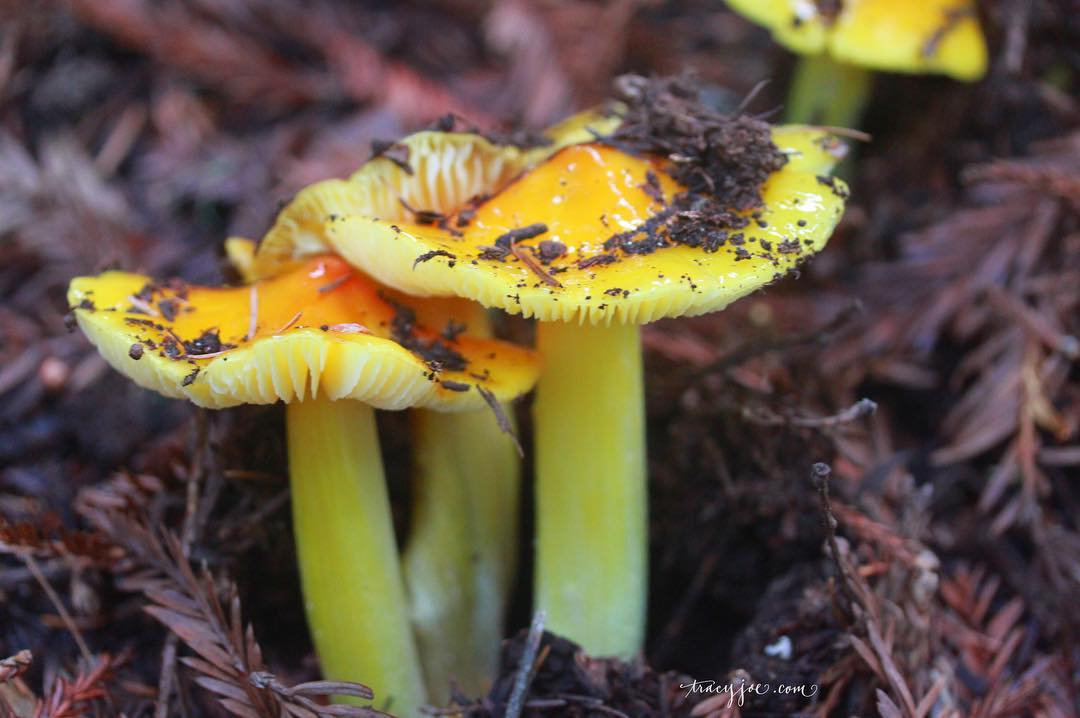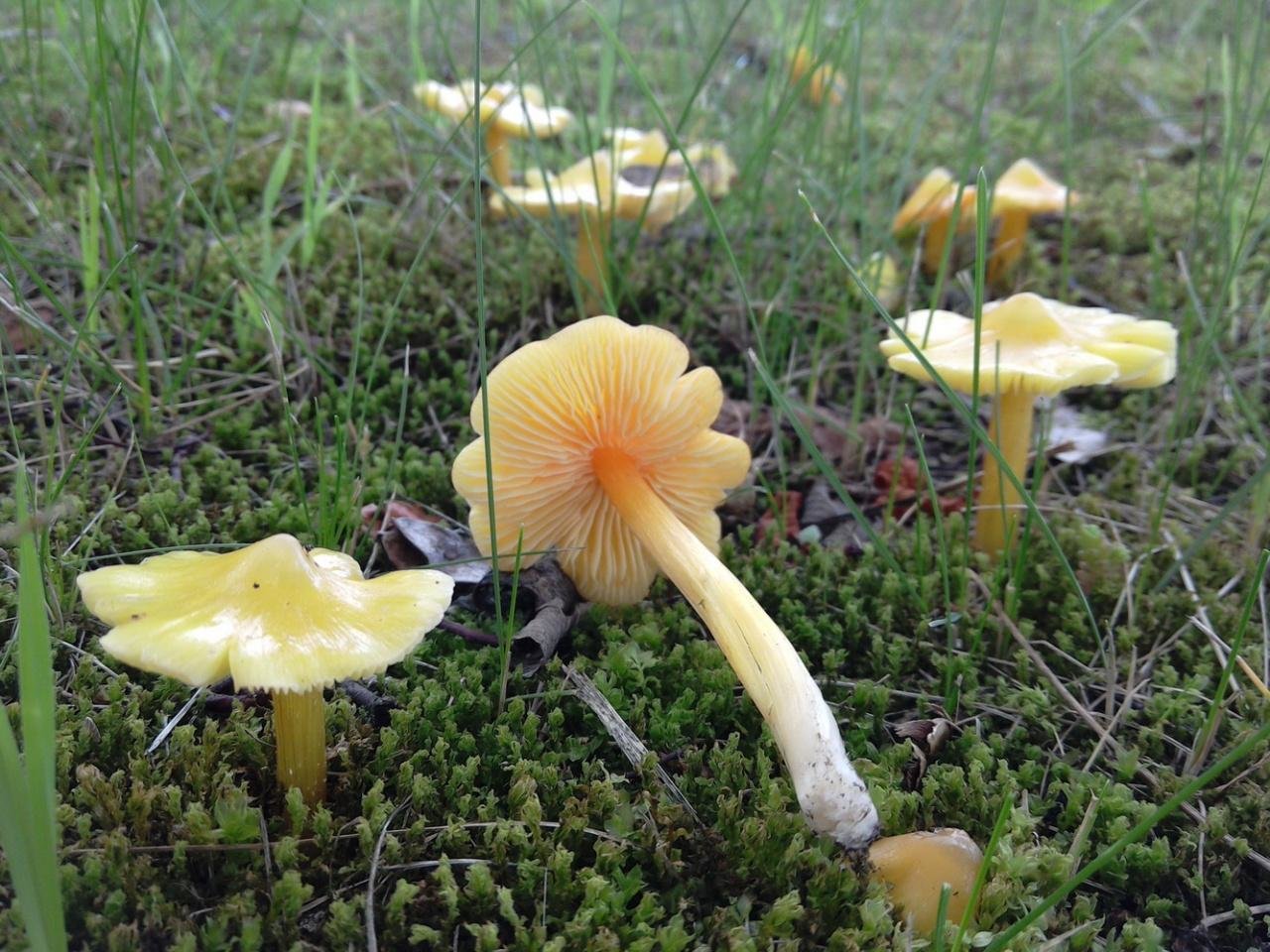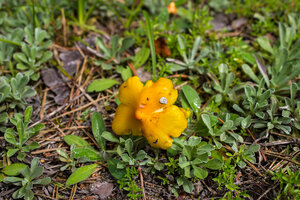Hygrocybe acute conical: description and photo
| Name: | Hygrocybe acute conical |
| Latin name: | Hygrocybe acutoconica |
| Type of: | Inedible |
| Synonyms: | Hygrocybe persistens |
| Specifications: |
|
| Systematics: |
|
The conical hygrocybe is a member of the widespread genus Hygrocybe. The definition arose from the sticky skin of the top of the fruiting body, soaked in liquid. In the scientific literature, the mushroom is called: hygrocybe persistent, Hygrocybe persistens, Hygrocybe acutoconica, Hygrocybe conica.
There is another option for domestic use: a wet head.

A distinctive feature of the inedible variety is the pointed tip of the bright mushroom body
What does a hygrocybe look like?
The cap has a tapered cone shape, which is especially characteristic of young mushrooms. As the edges grow, they move away, the silhouette of the apex becomes wide-conical. The tubercle in the middle remains, the fragile border often breaks. Thin-fibred, smooth skin becomes slippery, sticky after rain. In the dry period, it seems shiny, silky. The width of the upper part is up to 9 cm, so the mushroom is noticeable both in size and in bright color:
- the entire surface area is yellow-orange or yellowish;
- the elevation in the center is much more intense in color.
At the end of growth, the entire surface becomes darker. When pressed on the fruit body, the skin also darkens.
Light yellow plates of the type are loose or, conversely, are tightly attached to the cap. Their edges are widened. Often the plates do not reach the rim. In old mushrooms, the plates are grayish; when pressed, a dark gray color also appears.
Thin yellowish pulp is fragile, because of this, the edge is often torn, after pressure it turns black. Spore powder is white.
High, up to 10-12 cm, the stem is very thin, only 9-10 mm. Smooth, straight, slightly thickened at the base, fine-fibered, hollow inside. The color of the surface corresponds to the shade of the top, at the bottom it lightens to white.

Fruit bodies of a wet head with toxic substances are distinguished by long thin legs, which distinguish them from similar species
Where does the hygrocybe grow acutely
The species is common in Eurasia and North America in the temperate zone, especially in warm regions. More often, brightly colored mushroom families are found in wet meadows, in old gardens, less often in glades and edges of mixed forests from late spring to the first frost. Hygrocybe sharp-conical prefers alkaline sandy soil, grows under solitary deciduous trees.
Fruit bodies are similar to other wet heads with a brightly colored surface, especially a slightly poisonous conical hygrocybe, the surface of which darkens after pressing.

The fruiting body of a similar mushroom turns black after ripening.
Is it possible to eat a hygrocybe acutely conical
Toxic substances have been identified in the pulp of yellowish-orange moist heads with a pointed tip. The conical hygrocybe is inedible. No pronounced odor emanates from the pulp. Poisons of the sharp-conical type are not fatal, but can cause serious illness. An orange-yellow cone-shaped hat with a pointed tubercle in the center should serve as a warning to inexperienced mushroom pickers.
Conclusion
The conical hygrocybe is a representative of a widespread genus, which includes small mushroom bodies, conditionally edible and inedible, some of which are poisonous. The brightly colored pointed tip signals that the mushroom should not be picked.
Hygrocybe conical edibility, what it looks like, where it grows, how to distinguish it, photo
Hygrocybe cone-shaped: description and photo
Hygrocybe conica is not such a rare mushroom. Many saw him, even kicked him down.Mushroom pickers sometimes call it a wet head. It belongs to the lamellar mushrooms from the Gigroforov family.
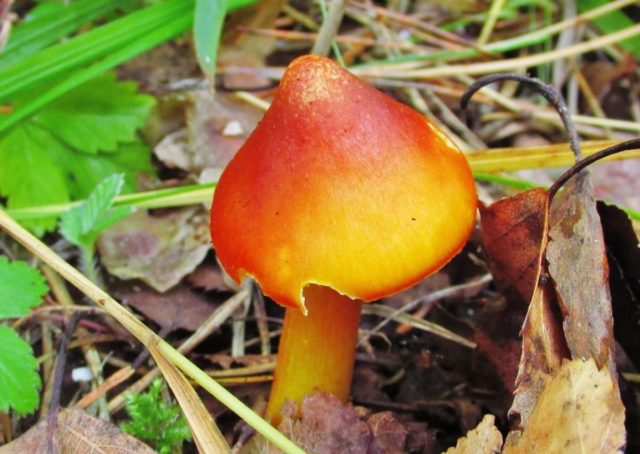
How does a cone-shaped hygrocybe look
The description is necessary, because novice mushroom pickers very often take all the fruit bodies that come to hand, without thinking about their benefits or harms.
The cone-shaped hygrocybe has a small cap. The diameter, depending on age, can be 2-9 cm. In young mushrooms, it is in the form of a pointed cone, bell or hemispherical. In mature wet heads, it becomes broadly conical, but a tubercle remains at the very top. The older the cone-shaped hygrocybe, the more breaks on the cap, and the plates are perfectly visible.
When it rains, the surface of the crown shines and becomes sticky. In dry weather, it is silky and shiny. In the wilderness, mushrooms with red-yellow and red-orange caps are found, and the tubercle is somewhat brighter than the entire surface.
Legs are long, even, straightened, fine-fiber and hollow. At the very bottom, they have a small thickening. In shade, they are almost the same as the caps, but the base is whitish. There is no mucus on the legs.
In some specimens, the plates are attached to the cap, however, there are cone-shaped hygrocybe, in which this part is free. The plates are narrow right in the center, but widen at the edges. The part located at the bottom is yellowish. The older the mushroom, the grayer this surface. Turns greyish yellow when touched or pressed.
They are distinguished by a thin and very fragile pulp. In shade, it does not stand out from the fruiting body itself. Turns black when pressed. The pulp does not stand out with its taste and aroma, they are faceless.
Ellipsoidal spores are white. They are miniature - 8-10 by 5-5.6 microns, smooth. There are buckles on the hyphae.
Where the cone-shaped hygrocybe grows
Vlazhnogolovka prefers young plantings of birches and aspens. Loves to breed in moorlands and along roads. Where there is a lot of grassy cover:
- along the very edge of deciduous forests;
- on the edges, meadows, pastures.
Single specimens can be seen in pine forests.
Fruiting of a wet head is long. The first mushrooms are found in May, and the last ones grow until frost.
Is it possible to have a cone-shaped hygrocybe
Regardless of the fact that the cone-shaped hygrocybe is considered weakly poisonous, it should not be collected. And the thing is that it will cause big problems with the intestines.
Kindred hygrocybe cone-shaped
Other types of hygrocybe should be distinguished, which are similar to a cone-shaped one:
- Hygrocybe turunda or lint. In young specimens, the cap is convex, then a depression appears in it. Flakes are perfectly visible on a dry surface. In the very center, it is red, at the edges it is much lighter, almost yellow. The leg is cylindrical, thin, with a slight curvature. A whitish bloom is visible on the base. The fragile whitish pulp is inedible. Fruiting lasts from May to October. Refers to inedible.
- Oak hygrocybe is very similar to a wet head. Young mushrooms have a cone-shaped cap with a diameter of 3-5 cm, which is then leveled. It is yellow-orange in color. When the weather is damp, mucus appears on the cap. The plates are rare, of the same shade. The taste and smell of the yellowish pulp is pale. Yellow-orange legs up to 6 cm long, ultra-thin, hollow, slightly curved.
- Oak hygrocybe, unlike its congeners, is conditionally edible. Occurs in mixed forests, but most expediently bears fruit under oak trees.
- The hygrocybe is acutely conical or persisting. The shape of the yellow or yellow-orange cap changes with age. First of all, it is conical, after which it becomes wide, but the tubercle still remains. There are fibers on the mucous surface of the cap. The pulp is virtually odorless and tasteless. The legs are the highest - up to 12 cm, diameter - about 1 cm.
Conclusion
The cone-shaped hygrocybe is an inedible, weakly dangerous mushroom.It can cause problems with the gastrointestinal tract, so it is not eaten. But being in the wilderness, you should not knock down the fruit bodies with your feet, because in nature there is nothing useless. Basically, the inedible and overgrown gifts of the forest are considered food for animals.
Distinctive features of a cap-shaped hygrocybe
The diameter of the cap varies from 2 to 6 centimeters. A young mushroom has a pointed-shaped cap, in fact, thanks to this, the name came about. Over time, the shape of the cap becomes more sloping, and in mature mushrooms it spreads completely.
At first, the color of the mushroom is quite bright: coral-red, terracotta, wine-brown, orange, and at the end of the season the mushroom fades and becomes light pink. The central part of the cap is much lighter, even whitish. The surface can be sticky or dry. The edges are clearly serrated.
The pulp is pink, thin, and quickly falls apart in the hands. The plates are attached to the stem with the help of teeth. Their colors are mostly light, pale pink. They can be located frequently or infrequently.
The stem of this family of mushrooms can be quite long and reach 16 centimeters. But often there are cap-shaped hygrocybes with short legs that do not exceed 2 centimeters. The leg has a small thickness - only 1 centimeter, so it is very fragile. The surface of the leg is completely smooth, without roughness. The leg is firmly fixed in the substrate. Its shape can be ovoid or elliptical. The spore sac is white or light cream.
Spreading cap-shaped hygrocybe
These mushrooms originally became known in Europe, North America and Japan. Most often, cap-shaped hygrocybe grow in groups, and separately growing specimens are rare.
These mushrooms grow in humus and soil, they prefer rich soil. They can be found in mixed and coniferous forests. Cap-shaped hygrocybe is a moderately common type of mushroom.
Edible hygrocybe cap-shaped
The cap-shaped hygrocybe is considered an edible species, but mushroom pickers collect it quite rarely, since it does not differ in special taste, there is also no smell.
Related species
- Hygrocybe scarlet, she is also hygrocybe red, has a variable color from bright scarlet to pale orange. These mushrooms grow in meadows, meeting from late summer to late autumn. Scarlet hygrocybe is not popular as an edible species, but it is a non-poisonous mushroom;
- Hygrocybe wax is a bright orange mushroom. They grow singly or in small groups. The distribution area covers Europe and North America. The wax hygrocybe is inedible, but, most likely, non-toxic, since no cases of poisoning have been recorded;
- Oak hygrocybe has a yellow-orange color. The growing places of these mushrooms are deciduous and mixed forests, most often they are found near oak trees. The mushroom is not poisonous, but has no nutritional value;
- Hygrocybe cinnabar red is distinguished by cinnabar red color. It grows in mossy and grassy places, in glades, meadows and wetlands. Occurs from July to August. The opinions of mushroom pickers differ on the nutritional qualities of this mushroom, some claim that it is an inedible mushroom, and others that they can be eaten, but they have no practical significance;
- The conical hygrocybe is characterized by a yellowish, orange and in some places reddish color. These mushrooms grow mainly in young rare plantings and along roads, and in forests they are more rare. They bear fruit from May to October. The conical hygrocybe is not suitable for eating, as it can provoke an upset stomach. It is considered a slightly poisonous mushroom;
- The beautiful hygrocybe has a very varied color: light wine-gray, lilac-gray, olive, red-red and red-orange, sometimes it can be pinkish and greenish. These mushrooms are widespread in South America, North America, Europe and Japan.They grow in groups on humus, meeting in coniferous and mixed forests;
- Crimson hygrocybe is distinguished by its crimson or red color. Turning into orange. These fungi are ubiquitous in humid, open areas. It is a good-tasting edible mushroom that can be fried and canned;
- Hygrocybe turunda is a bright red inedible mushroom found in summer and autumn;
- Hygrocybe acutely conical is characterized by a yellow-orange or yellow color. Grows in meadows and pastures of various types. Fruiting time is in summer and autumn. These are inedible mushrooms, as they contain toxic substances.
Hygrocybe conical edibility, what it looks like, where it grows, how to distinguish it, photo
Hygrocybe cone-shaped: description and photo
Hygrocybe conica is not such a rare mushroom. Many saw him, even kicked him down. Mushroom pickers sometimes call it a wet head. It belongs to the lamellar mushrooms from the Gigroforov family.

How does a cone-shaped hygrocybe look
A description is needed, because novice mushroom pickers very often take all the fruit bodies that come to hand, without thinking about their benefits or harms.
The cone-shaped hygrocybe has a small cap. The diameter, depending on age, can be 2-9 cm. In young mushrooms, it is in the form of a pointed cone, bell or hemispherical. In mature wet heads, it becomes broadly conical, but a tubercle remains at the very top. The older the cone-shaped hygrocybe, the more breaks on the cap, and the plates are perfectly visible.
When it rains, the surface of the crown shines and becomes sticky. In dry weather, it is silky and shiny. In the wilderness, mushrooms with red-yellow and red-orange caps are found, and the tubercle is somewhat brighter than the entire surface.
Legs are long, even, straightened, fine-fiber and hollow. At the very bottom, they have a small thickening. In shade, they are almost the same as the caps, but the base is whitish. There is no mucus on the legs.
On some specimens, the plates are attached to the cap, however, there are cone-shaped hygrocybe, in which this part is free. The plates are narrow right in the center, but widen at the edges. The part located at the bottom is yellowish. The older the mushroom, the grayer this surface. Turns greyish yellow when touched or pressed.
They are distinguished by a thin and very fragile pulp. In shade, it does not stand out in any way from the fruiting body itself. Turns black when pressed. The pulp does not stand out with its taste and aroma, they are faceless.
Ellipsoidal spores are white. They are miniature - 8-10 by 5-5.6 microns, smooth. There are buckles on the hyphae.
Where the cone-shaped hygrocybe grows
Vlazhnogolovka prefers young plantings of birches and aspens. Loves to breed in moorlands and along roads. Where there is a lot of grassy cover:
- along the very edge of deciduous forests;
- on the edges, meadows, pastures.
Single specimens can be seen in pine forests.
Fruiting of a wet head is long. The first mushrooms are found in May, and the last ones grow until frost.
Is it possible to have a cone-shaped hygrocybe
Regardless of the fact that the cone-shaped hygrocybe is considered weakly poisonous, it should not be collected. And the thing is that it will cause big problems with the intestines.
Kindred hygrocybe cone-shaped
Other types of hygrocybe should be distinguished, which are similar to a cone-shaped one:
- Hygrocybe turunda or lint. In young specimens, the cap is convex, then a depression appears in it. Flakes are perfectly visible on a dry surface. In the very center, it is red, at the edges it is much lighter, almost yellow. The leg is cylindrical, thin, with a slight curvature. A whitish bloom is visible on the base. The fragile whitish pulp is inedible. Fruiting lasts from May to October. Refers to inedible.
- Oak hygrocybe is very similar to a wet head. Young mushrooms have a cone-shaped cap with a diameter of 3-5 cm, which is then leveled. It is yellow-orange in color.When the weather is damp, mucus appears on the cap. The plates are rare, of the same shade. The taste and smell of the yellowish pulp is pale. Yellow-orange legs up to 6 cm long, ultra-thin, hollow, slightly curved.
- Oak hygrocybe, unlike its congeners, is conditionally edible. Occurs in mixed forests, but most expediently bears fruit under oak trees.
- The hygrocybe is acutely conical or persisting. The shape of the yellow or yellow-orange cap changes with age. First of all, it is conical, after which it becomes wide, but the tubercle still remains. There are fibers on the mucous surface of the cap. The pulp is virtually odorless and tasteless. The legs are the highest - up to 12 cm, diameter - about 1 cm.
Conclusion
The cone-shaped hygrocybe is an inedible, weakly dangerous mushroom. It can cause problems with the gastrointestinal tract, so it is not eaten. But being in the wilderness, you should not knock down the fruit bodies with your feet, because in nature there is nothing useless. Basically, the inedible and overgrown gifts of the forest are considered food for animals.
Hygrocybe acute conical: description and photo
| Name: | Hygrocybe acute conical |
| Latin name: | Hygrocybe acutoconica |
| Type of: | Inedible |
| Synonyms: | Hygrocybe persistens |
| Specifications: |
|
| Systematics: |
|
The conical hygrocybe is a member of the widespread genus Hygrocybe. The definition arose from the sticky skin of the top of the fruiting body, soaked in liquid. In the scientific literature, the mushroom is called: hygrocybe persistent, Hygrocybe persistens, Hygrocybe acutoconica, Hygrocybe conica.
There is another option for domestic use: a wet head.
A distinctive feature of the inedible variety is the pointed tip of the bright mushroom body
What does a hygrocybe look like?
The cap has a tapered cone shape, which is especially characteristic of young mushrooms. As the edges grow, they move away, the silhouette of the apex becomes wide-conical. The tubercle in the middle remains, the fragile border often breaks. Thin-fibred, smooth skin becomes slippery, sticky after rain. In the dry period, it seems shiny, silky. The width of the upper part is up to 9 cm, so the mushroom is noticeable both in size and in bright color:
- the entire surface area is yellow-orange or yellowish;
- the elevation in the center is much more intense in color.
At the end of growth, the entire surface becomes darker. When pressed on the fruit body, the skin also darkens.
Light yellow plates of the type are loose or, conversely, are tightly attached to the cap. Their edges are widened. Often the plates do not reach the rim. In old mushrooms, the plates are grayish; when pressed, a dark gray color also appears.
Thin yellowish pulp is fragile, because of this, the edge is often torn, after pressure it turns black. Spore powder is white.
High, up to 10-12 cm, the stem is very thin, only 9-10 mm. Smooth, straight, slightly thickened at the base, fine-fibered, hollow inside. The color of the surface corresponds to the shade of the top, at the bottom it lightens to white.
Fruit bodies of a wet head with toxic substances are distinguished by long thin legs, which distinguish them from similar species
Where does the hygrocybe grow acutely
The species is common in Eurasia and North America in the temperate zone, especially in warm regions. More often, brightly colored mushroom families are found in wet meadows, in old gardens, less often in glades and edges of mixed forests from late spring to the first frost. Hygrocybe sharp-conical prefers alkaline sandy soil, grows under solitary deciduous trees.
Fruit bodies are similar to other wet heads with a brightly colored surface, especially a slightly poisonous conical hygrocybe, the surface of which darkens after pressing.
The fruiting body of a similar mushroom turns black after ripening.
Is it possible to eat a hygrocybe acutely conical
Toxic substances have been identified in the pulp of yellowish-orange moist heads with a pointed tip. The conical hygrocybe is inedible. No pronounced odor emanates from the pulp. Poisons of the sharp-conical type are not fatal, but can cause serious illness. An orange-yellow cone-shaped hat with a pointed tubercle in the center should serve as a warning to inexperienced mushroom pickers.
Conclusion
The conical hygrocybe is a representative of a widespread genus, which includes small mushroom bodies, conditionally edible and inedible, some of which are poisonous. The brightly colored pointed tip signals that the mushroom should not be picked.


